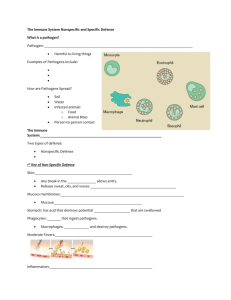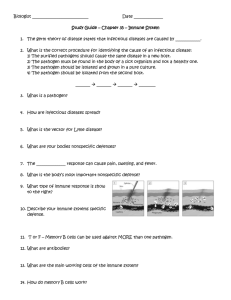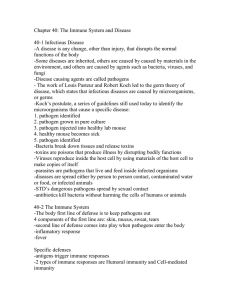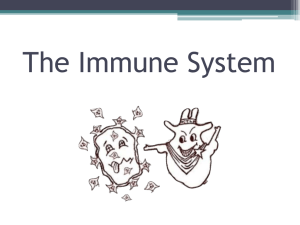life pps 35
advertisement
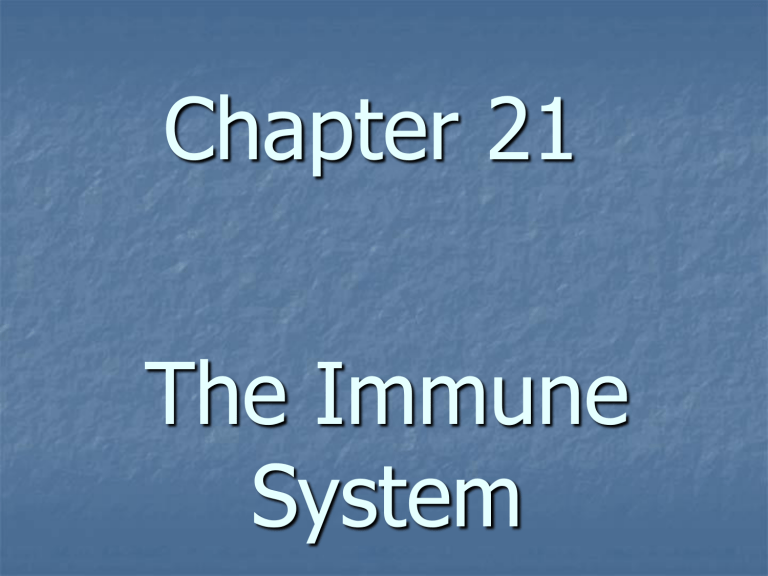
Chapter 21 The Immune System Function of the Immune System The immune system is a collection of mechanisms that protects against disease by identifying and killing pathogens and tumor cells. A pathogen is an organism or virus that causes a disease or disorder The Immune System detects a wide variety of agents, from viruses, bacteria, fungi & parasites Needs to distinguish them from our own healthy cells & tissue. Pathogen Types Infectious Diseases are caused by a pathogen – an organism or virus Fungi - mold Pathogens include various types of Bacteria, Viruses, Fungi & Protists Infectious diseases include: measles, mumps, pneumonia, chicken pox, HIV & AIDS, etc. HIV Virus Giardia (a protist) Flu Virus Bacteria Malaria (a protist) The Body Defenses 3 Lines of Defense: 1st Line: Barriers keep pathogens away 2nd Line: Inflammatory Response 3rd Line: The Immune Response The Body’s Defenses: 1st Line of Defense: Barriers Keep Pathogens from successfully attacking the body: Skin – waterproof barrier w/ destructive oils and sweat to help killoff pathogen Breathing Passages – nasal passages, trachea, bonchi and lungs lined w/ ciliated epithelial cells that secrete mucus and moved “captured” pathogens up & out of the respiratory tract to be expelled or swallowed! Mouth & Stomach – Saliva and stomach acids aid in killing off pathogens Ciliated Epithelium Skin forms protective layer Saliva & Stomach Acid destroy most pathogens The Body’s Defenses: 2nd Line of Defense: Damaged cells trigger the release of histamines: Blood vessels dilate (widen & enlarge) causing increased blood flow They leak plasma and white blood cells into the area causes swelling, redness, tenderness and fever. The Body’s Defenses: 3rd Line of Defense: The Immune Response White Blood Cells – WBC (phagocytes & lymphocytes) Phagocytes (AKA Macrophage)– Attack, engulf & eats pathogens and destroys them. 3 main types (“-phils” – latin suffix meaning “love”) Basophil Basophils – least abundant WBC “loves” base type stains – Eosinophils – “loves” eosin type stains Neutrophil – Most abundant WBC – “loves” neutral stains Eosinophil Neutrophil Phagocytes The Body’s Defenses: 3rd Line of Defense: The Immune Response New Terms: Antigen: usually a protein found on the cell membrane of the pathogen that has attacked the body Antibody: protein (nonliving) that reacts w/ antigen to mark the pathogen allowing it to be recognized & then eaten by a phagocyte T Cell B Cell The Body’s Defenses: 3rd Line of Defense: The Immune Response White Blood Cells – WBC Lymphocytes produce antibodies T cells : (made in the Thymus Gland) Over 10 million in your body each able to recognize specific antigens. Some attack & kill invading pathogen. Some stimulate B Cells to activate B cells: (made in the Bone marrow) Once activated, they produce thousands of antibodies that attack the pathogen T Cell B Cell No Mas… Immune system over and out!!

